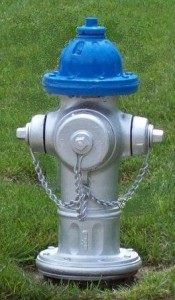Author: Captain Ninetta Violante
Important note:
Hydrants have to be flushed and the flow must be measured to ensure they work when they are needed. We understand that flowing these hydrants can occasionally discolor household water. For the next several weeks, please check for clarity of your water prior to laundering white clothing. If it is discolored, let your water run until clear before allowing the washing machine to fill.
Hydrants must be easily visible to arriving fire vehicles.
Painting Hydrants
________________________
You may have seen some City of Decatur Fire Fighters out painting and servicing hydrants. We usually do this twice a year. The hydrants in Decatur are painted according to the Insurance Services Offices and according to NFPA (National Fire Protection Agency) 291, it says fire hydrants using public water supply systems should be painted chrome, and their tops and caps should indicate the available GPM. Below 500GPM should be red, 500-999 GPM should be orange, 1000-1499 GPM should be green, and 1500 GPM or more should be blue. This usually signifies the size of the pipes underneath.
We usually do this twice a year. The hydrants in Decatur are painted according to the Insurance Services Offices and according to NFPA (National Fire Protection Agency) 291, it says fire hydrants using public water supply systems should be painted chrome, and their tops and caps should indicate the available GPM. Below 500GPM should be red, 500-999 GPM should be orange, 1000-1499 GPM should be green, and 1500 GPM or more should be blue. This usually signifies the size of the pipes underneath.
Some of the hydrants will have a black cap on the side which informs the firefighters that they need to turn the top in the opposite direction to open the hydrant. It is critical that the firefighters see this so if a resident paints over the color of the cap or the top of the hydrant, it could greatly affect fire operations. Hydrants must be easily visible to arriving fire vehicles.
Planting Next To Hydrants
__________________________
When firefighters arrive at a fire, they must quickly and easily locate the nearest fire hydrants. Most U.S. municipalities regulate what can be planted or placed near hydrants. They warn property owners not to obscure hydrants or impede access to them with plants, fences, walls, cars and the like. Imagine a firefighter arriving at night and having to waste valuable time cutting away brush to find a hydrant.
Fire Codes
In general, municipal fire codes require property owners to maintain a clearance of about 3 feet around fire hydrants. Shrubs, trees, fruit, vegetables and flowers are not to be planted inside that area. This doesn’t mean that nothing can be planted there, but that the plants you choose need to be low-growing so they won’t obscure visibility or access to the hydrant in any way.
Allowable Plants
Ground covers that grow nearly flat to the ground, such as creeping thyme (Thymus serpyllum), hardy in U.S. Department of Agriculture plant hardiness zones 4 through 8, are usually allowed next to hydrants, but lawn grass around a hydrant is required by the property owner to keep it mowed short. Mulching around the hydrant with bark is another option. The property owner is responsible for clearing away fall leaves and other debris that collect near the hydrant. From experience, I can say that planting shrubs or plants that have thorns and sharp leaves next to a hydrant is simply cruel.
Fire-Safe Choices
Along with being low-growing, plants near a fire hydrant should be fire-resistant, especially in areas with high fire danger, such as near woods or grassland. Fire-resistant plants usually have thick, moisture-retentive, green leaves and thin sap and don’t tend to accumulate dead leaves or wood. Possibilities include ice plant (Delosperma cooperi), which grows in USDA zones 6 through 10, and bugleweed (Ajuga reptans), which is hardy in USDA zones 4 through 10A.
Hydrant Maintenance
Fire departments need to consistently maintain hydrants so they will function correctly when needed. This includes flushing, inspecting, cleaning, painting and repairing. The workers who maintain the hydrants will need to walk, probe and possibly dig around the hydrant, so any plants there are likely to be routinely damaged. While lawn grass stands up best to such treatment, plants suitable for planting between paving stones for pathways also tolerate some foot traffic. Choices include acaena (Acaena spp.), hardy in USDA zones 7 through 9, and beach strawberry (Fragraria chiloensis), hardy in USDA zones 5 through 9.
Some information gathered from http://homeguides.sfgate.com/growing-plants-next-fire-hydrants-97594.html
If you have questions or concerns about any matters regarding these topics, please call the City of Decatur Fire Marshal at 678-553-6583.



